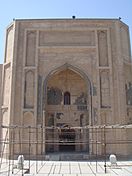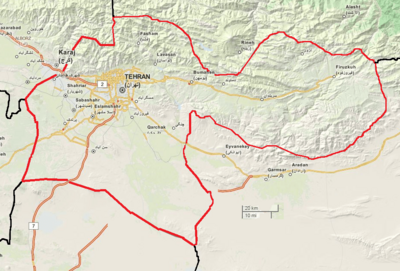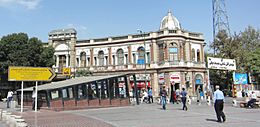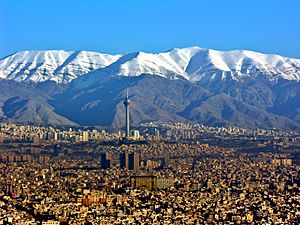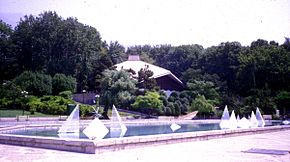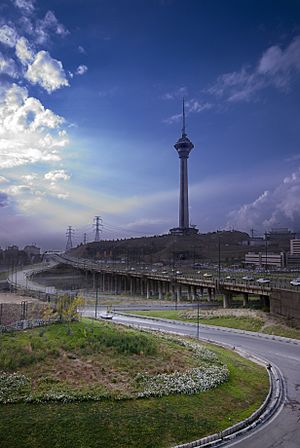Tehran province facts for kids
Quick facts for kids
Tehran province
|
|
|---|---|
|
From top left: Azadi Tower, Rudbar-e Qasran Road, Former building of Parliament of Iran, Tangeh Vashi, Tehran skyline view from top of Milad Tower, Jameh Mosque in Varamin, and Tughrul Tower in Rey
|
|

Counties of Tehran province
|
|

Location of Tehran province in Iran
|
|
| Country | Iran |
| Region | Region 1 |
| Capital | Tehran |
| Counties | 16 |
| Area | |
| • Total | 18,814 km2 (7,264 sq mi) |
| Population
(2016)
|
|
| • Total | 13,267,637 |
| • Estimate
(2020)
|
13,973,000 |
| • Density | 705.200/km2 (1,826.46/sq mi) |
| Time zone | UTC+03:30 (IRST) |
| ISO 3166 code | IR-23 |
| Main language(s) | Persian |
| HDI (2018) | 0.834 very high · 1st |
Tehran Province (Persian: استان تهران Ostān-e Tehrān) is one of the 31 provinces in Iran. It covers about 18,814 square kilometers. You can find it north of Iran's central plateau.
In 2006, the province had over 13 million people. Later, some areas like Karaj became part of a new province called Alborz province. By 2016, Tehran Province's population was still over 13 million. It's a very important part of Iran.
Tehran Province shares borders with several other provinces. To the north is Mazandaran province. To the south is Qom province. Semnan province is to the east. Alborz province is to the west, and Markazi province is to the southwest. The big city of Tehran is the capital of this province and also the capital city of all Iran.
This province is the richest in Iran. It makes up about 29% of the country's total economy. About 18% of Iran's people live here. It's also the most industrialized province. This means many factories and businesses are located here. In 2016, almost all its residents (94%) lived in cities.
Tehran Province became very important in 1778. That's when the Qajar dynasty made Tehran its capital. Today, Tehran city has about 8 million people. It is one of the 40 largest cities in the world.
Contents
History of Tehran Province
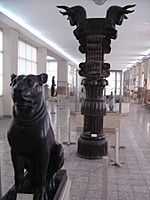
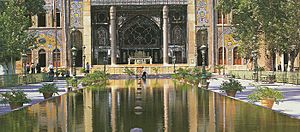
Tehran Province has many archeological sites. These places show that people lived here thousands of years ago. For a long time, Rey was the most important city in the province.
But then, the city of Tehran grew bigger. By 1778, it became the capital of Iran. Since then, Tehran has been the main center for politics, culture, business, and trade in Iran.
Tehran has over 1,500 historical places. These are important for Iran's culture. The oldest sites in Tehran Province are in Firuzkuh County. They are from around 4,000 BCE.
Geography and Climate
Tehran Province has more than 12 million people. It is Iran's most densely populated area. Most people (about 86.5%) live in cities. About 13.5% live in rural areas.
The biggest rivers here are the Karaj River and the Jajrood River.
Many mountain ranges are in the province. The Alborz mountains are in the north. Savad Kooh and Firooz Kooh are in the northeast. Other mountains like Lavasanat and Qarah Daq are in the south.
The weather in Tehran Province changes with the seasons. Winters are cold and snowy. Spring and autumn are mild with lots of rain. Summers are warm to hot and usually dry. In the mountains, it's cold and a bit wet all year. Higher areas are even colder with long winters.
The hottest months are from mid-July to mid-September. Temperatures are usually around 28°C to 30°C (82°F to 86°F). The coldest months are January and February, with temperatures around 1°C (34°F). But sometimes in winter, it can drop to -20°C (-4°F). Tehran city itself has cold winters and warm to hot summers.
On average, it rains about 200 mm (8 inches) each year. Most of this rain falls as snow in winter. Overall, the southern part of the province has a cold semi-arid or steppe climate. The northern part has an alpine climate.
Administrative Divisions
Tehran Province is divided into different areas called counties. Each county has its own cities and towns. The capital city of the province is Tehran.
The table below shows how the population of Tehran Province's counties has changed over time. Some counties were created later or moved to other provinces.
| Administrative Divisions | 2006 | 2011 | 2016 |
|---|---|---|---|
| Baharestan County1 | — | 523,636 | 536,329 |
| Damavand County | 96,860 | 100,690 | 125,480 |
| Eslamshahr County | 447,192 | 485,688 | 548,620 |
| Firuzkuh County | 37,416 | 38,712 | 33,558 |
| Karaj County2 | 1,709,481 | — | — |
| Malard County3 | — | 373,994 | 377,292 |
| Nazarabad County2 | 128,666 | — | — |
| Pakdasht County | 240,841 | 291,397 | 350,966 |
| Pardis County4 | — | — | 169,060 |
| Pishva County5 | — | 75,454 | 86,601 |
| Qarchak County5 | — | — | 269,138 |
| Qods County3 | — | 290,663 | 316,636 |
| Ray County | 292,016 | 319,305 | 349,700 |
| Robat Karim County | 608,530 | 195,917 | 291,516 |
| Savojbolagh County2 | 215,086 | — | — |
| Shahriar County | 1,044,707 | 624,440 | 744,210 |
| Shemiranat County | 37,778 | 44,061 | 47,279 |
| Tehran County | 7,882,843 | 8,293,140 | 8,737,510 |
| Varamin County | 540,442 | 526,294 | 283,742 |
| Total | 13,281,858 | 12,183,391 | 13,267,637 |
| 1Separated from Robat Karim County 2Separated from Tehran province 3Separated from Shahriar County 4Separated from Tehran County 5Separated from Varamin County |
|||
Major Cities in Tehran Province
Most of the people in Tehran Province live in cities. In 2016, about 12.4 million people lived in the cities listed below. The biggest city is Tehran itself.
| Rank | Name | County | 2016 |
|---|---|---|---|
| 1 | Tehran | Tehran | 8,693,706 |
| 2 | Eslamshahr | Eslamshahr | 448,129 |
| 3 | Shahriar | Shahriar | 309,607 |
| 4 | Qods | Qods | 309,605 |
| 5 | Malard | Malard | 281,027 |
| 6 | Golestan | Baharestan | 239,556 |
| 7 | Pakdasht | Pakdasht | 236,319 |
| 8 | Qarchak | Qarchak | 231,075 |
| 9 | Varamin | Varamin | 225,628 |
| 10 | Nasimshahr | Baharestan | 200,393 |
Tehran Province Today
Tehran is a major business center in Iran. The province has over 17,000 factories and businesses. These employ about 390,000 people. This is 26% of all such businesses in Iran.
Tehran Province makes up 30% of Iran's economy. It also has 40% of Iran's customers. The province gets its water from three large dams: Latiyan, Lar, and Amir Kabir. There are also two natural lakes.
The province has 170 mines. It also has over 330 square kilometers of forests. Plus, there are over 12,800 square kilometers of pastures for animals.
Many places in the province are great for recreation. The southern slopes of the Alborz Mountains are popular. Valleys, rivers, and lakes behind the big dams are also fun. Natural lakes like Jaban and Tarr offer beautiful scenery.
In winter, the northern areas get a lot of snow. This makes the Alborz mountains perfect for winter sports like skiing. Dizin, Shemshak, and Tochal are very popular ski resorts.
Transportation in Tehran Province
Tehran Province has a big network of freeways and expressways. These roads help people travel easily.
Major Roads and Freeways
- Freeway 2 (Tehran–Karaj Freeway): Connects Tehran to Karaj and continues towards Tabriz.
- Freeway 5 (Tehran–Saveh Freeway): Links Tehran to its southern suburbs.
- Freeway 7 (Tehran–Qom Freeway): Connects Tehran to Imam Khomeini International Airport and Qom.
- Tehran–Pardis Freeway: Goes to northeastern suburbs like Pardis.
- Tehran–Shomal Freeway: This freeway is still being built. It will connect Tehran to Chalus in the north.
- Makhsus Road: An older road from Tehran to Karaj. Trucks often use this road.
- Road 65 (Saidi Expressway): Connects Tehran to southern suburbs like Eslamshahr.
- Road 71 (Qom old Road): An older road to Qom, still important for transit.
- Haraz Road: Connects Tehran to cities like Damavand and continues to Mazandaran province.
- Firuzkuh Road: Links Tehran to Firuzkuh and Qaemshahr.
Rail Network
National Rail Network
Tehran city is connected by train lines to the North, South, West, and East of Iran. You can even take a train from Tehran to Istanbul. RAJA is Iran's national railway company, and its main office is in Tehran. There are plans to build fast train lines from Tehran to Mashhad and Isfahan.
Tehran Metro
Tehran has a metro system. It has three lines that run within the city. There is also one line that goes to Karaj and western suburbs. Plans are in place to add more lines in the future.
Airports
Tehran Province has two main airports for passengers:
- Mehrabad Airport
- Imam Khomeini Airport
There are also several air force bases in the province.
Parks, Recreation, and Attractions
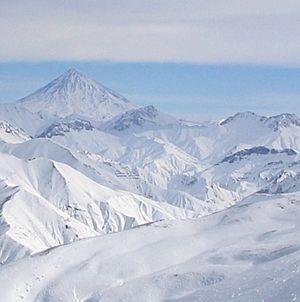
Tehran Province offers many places for fun and relaxation.
- Darband: A popular place for hiking.
- Chitgar Park
- Mellat Park
- Laleh Park
- Jamshidieh Park
- Niavaran Park
- Sa'ei Park
- Shatranj Park
- Tangeh Savashi: A beautiful gorge.
- Police Park
- Darabad hiking trail
- Darakeh hiking trail
- Jahan-e Kudak Park
- Azadi Sports complex
- Enghelab Sports Complex and Golf course
- Eram Amusement Park
- Many caves, springs, and waterfalls outside Tehran.
- Latyan Lake
- Lavizan Forest Park
- Vard-Avard Forest Park
- Khojir National Park
- Kavir National Park
- Tar Lake
- Amir Kabir Lake
- Lar Protected Natural Habitat
- Varjeen Protected Natural Habitat
Religious Centers
Tehran Province has many important religious sites.
Mosques, Shrines, and Tombs
- Soltani Mosque: Built by Fath Ali Shah.
- Atiq Mosque: Built in 1663.
- Mo'ezz o-dowleh mosque: Also built by Fath Ali Shah.
- Al-javad mosque: Iran's first mosque with a modern design.
- The Old Sepahsalar mosque: An important mosque from the Qajar dynasty era.
- The new Sepahsalar Mosque (Madreseh e Motahari).
- Many Imam-zadeh shrines: These are hundreds of years old, like the shrine of Imam Zadeh Saleh.
- Dozens of Saqa Khanehs: Traditional places for prayer.
- Several Tekyehs: Traditional places for ceremonies, especially during Muharram.
- Ebn-e Babooyeh cemetery: Many famous Iranians are buried here, like Gholamreza Takhti.
- Zahir o-dowleh cemetery: This is where many artists and cultural figures are buried.
- Kordan Tomb: From the Seljuqi era, located in Karaj.
- Maydanak Tomb: From the 13th century, also in Karaj.
- The Polish cemetery: North of Tehran, where many Allied soldiers from World War II are buried.
Churches
- Surep Georg Church: Built in 1790.
- Thaddeus Bartoqimus Church: Built in 1808.
- Enjili Church: Built in 1867.
- Assyrian Church.
Higher Education
Tehran Province is home to many major universities and colleges. These institutions offer a wide range of studies for students.
- Allameh Tabatabaii University
- Amirkabir University of Technology (Tehran Polytechnic)
- Alzahra University
- Iran University of Science and Technology (IUST)
- Imam Sadeq University (ISU)
- Iran University of Medical Sciences
- K.N.Toosi University of Technology
- Shahid Beheshti University
- Sharif University of Technology
- Tarbiat Modarres University
- Tehran University of Medical Sciences
- University of Tehran
- Islamic Azad University Central Tehran Branch
- Shahid Beheshti University of Medical Sciences
- Institute for Studies in Theoretical Physics and Mathematics (IPM)
- Payame Noor University
See also
 In Spanish: Provincia de Teherán para niños
In Spanish: Provincia de Teherán para niños
- Architecture of Tehran
- Economy of Iran
- Tehran (city)






